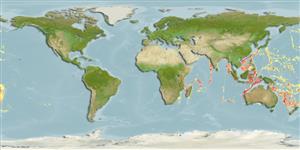Classification / Names
Noms communs | Synonymes | Catalog of Fishes(Genre, Espèce) | ITIS | CoL | WoRMS | Cloffa
>
Gadiformes (Cods) >
Macrouridae (Grenadiers or rattails)
Etymology: Mataeocephalus: Greek, maa, mataio = silliness + Greek,kepahle = head (Ref. 45335); cristatus: Name from Latin crista for crest, referring to the slightly enlarged middle row of spinules on most body scales.
More on authors: Sazonov, Shcherbachev & Iwamoto.
Environment: milieu / climate zone / depth range / distribution range
Écologie
marin benthopélagique; profondeur 1000 - 1720 m (Ref. 75667). Tropical
Indo-West Pacific: Indian Ocean (Saya de Malha Bank, Mascarene Ridge, Markus-Necker Ridge, Ninety East Ridge); Western Pacific (South China Sea),
Taille / Poids / Âge
Maturity: Lm ? range ? - ? cm
Max length : 27.1 cm TL mâle / non sexé; (Ref. 75667)
Life cycle and mating behavior
Maturité | Reproduction | Frai | Œufs | Fécondité | Larves
Sazonov, Y.I., Y.N. Shcherbachev and T. Iwamoto, 2003. The grenadier genus Mataeocephalus Berg, 1898 (Teleostei, Gadiformes, Macrouridae), with descriptions of two new species. Proc. Calif. Acad. Sci., v. 54 (no. 17):279-301. (Ref. 75667)
Statut dans la liste rouge de l'IUCN (Ref. 130435: Version 2024-2)
Menace pour l'homme
Harmless
Utilisations par l'homme
Outils
Articles particuliers
Télécharger en XML
Sources Internet
Estimates based on models
Preferred temperature (Ref.
123201): 2.5 - 5.2, mean 3.8 °C (based on 352 cells).
Phylogenetic diversity index (Ref.
82804): PD
50 = 0.5156 [Uniqueness, from 0.5 = low to 2.0 = high].
Bayesian length-weight: a=0.00575 (0.00194 - 0.01707), b=3.08 (2.83 - 3.33), in cm total length, based on LWR estimates for this (Sub)family-body shape (Ref.
93245).
Niveau trophique (Ref.
69278): 3.5 ±0.5 se; based on size and trophs of closest relatives
Résilience (Ref.
120179): Milieu, temps minimum de doublement de population : 1,4 à 4,4 années (Preliminary K or Fecundity.).
Fishing Vulnerability (Ref.
59153): Low vulnerability (17 of 100).
